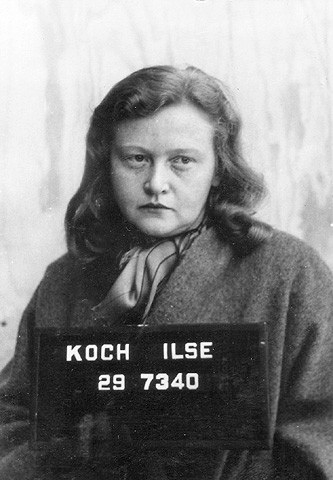Ilse Koch, popularly known as “The Beast of Buchenwald” and “The Witch of Buchenwald,” was one of the most notorious figures of the Second World War. She played a pivotal role in the atrocities committed at the Buchenwald concentration camp, where she terrorized the prisoners with her sadistic obsession with their tattoos, which she collected as souvenirs.
Ilse Koch was born in Dresden, Germany, in 1906. She married Karl Koch, a high-ranking Nazi official, in 1931, and together they had two children. Her husband headed the Buchenwald camp, where Ilse Koch served as an adviser on women’s issues. However, her true role in the camp was far more sinister.
One of Ilse’s most twisted habits was collecting the skin of Buchenwald prisoners with distinct tattoos as souvenirs. She would often ride her horse through the camp and stop to search for tattoos that caught her eye. Once she had located a prisoner with a unique tattoo, they were captured, stripped of their skin, and preserved to be displayed as trophies. The prisoner would then be killed and incinerated. Some say that she even had a handbag made from the skin she had collected.
Ilse Koch’s obsession with tattoos began after meeting several Romani inmates at the camp who had unique and intricate tattoo designs. She became fascinated by their body art and began collecting their skin. Some Romani inmates reported being tattooed against their will by Ilse Koch’s orders, with the promise that they wouldn’t be hurt if they cooperated.
Ilse Koch’s delight in human suffering was not confined to the collection of skin. She would often encourage her guards to torture and kill prisoners in front of her, watching as they screamed in agony. Her cruelty would also extend to forcing prisoners to tattoo each other in a manner that pleased her before being killed for their newly inked skin.
In 1945, as the war drew to a close, American and Soviet troops simultaneously entered the Buchenwald concentration camp. Ilse Koch escaped with her husband to Argentina, where they lived in comfortable seclusion. However, their downfall arrived in 1957, when they were arrested by police in Brazil and extradited to Germany. Ilse Koch was sentenced to life in prison for her crimes, while her husband committed suicide a few months after his own trial.
Ilse Koch’s trial involved the presentation of skin samples taken from Buchenwald prisoners, which was a stunning and disturbingly eerie reminder of her twisted past. The samples were an essential part of the proceedings and served as timeless proof of the horrors inflicted by Ilse Koch and the notorious Buchenwald concentration camp.
Ilse Koch committed suicide in 1967 at the age of 60, as her trial continued. It is unclear why she chose to take her own life, but some speculate that it was a way to avoid a public yielding that could have spilled the beans about the camp’s numerous atrocities, including the skin collection, torture, and killings she was known for.
To this day, Ilse Koch remains one of the most notoriously evil figures of the Second World War. Her name stands as a chilling reminder of the horrors inflicted during one of history’s darkest moments. Her skin collection, an eerie testament to the depravity of the Third Reich, serves as a chilling symbol of the barbarism that plagued Europe during the war. Her story is a lesson in the depravity of human nature and a stark warning against the dangers of obsession, cruelty, and hatred.



